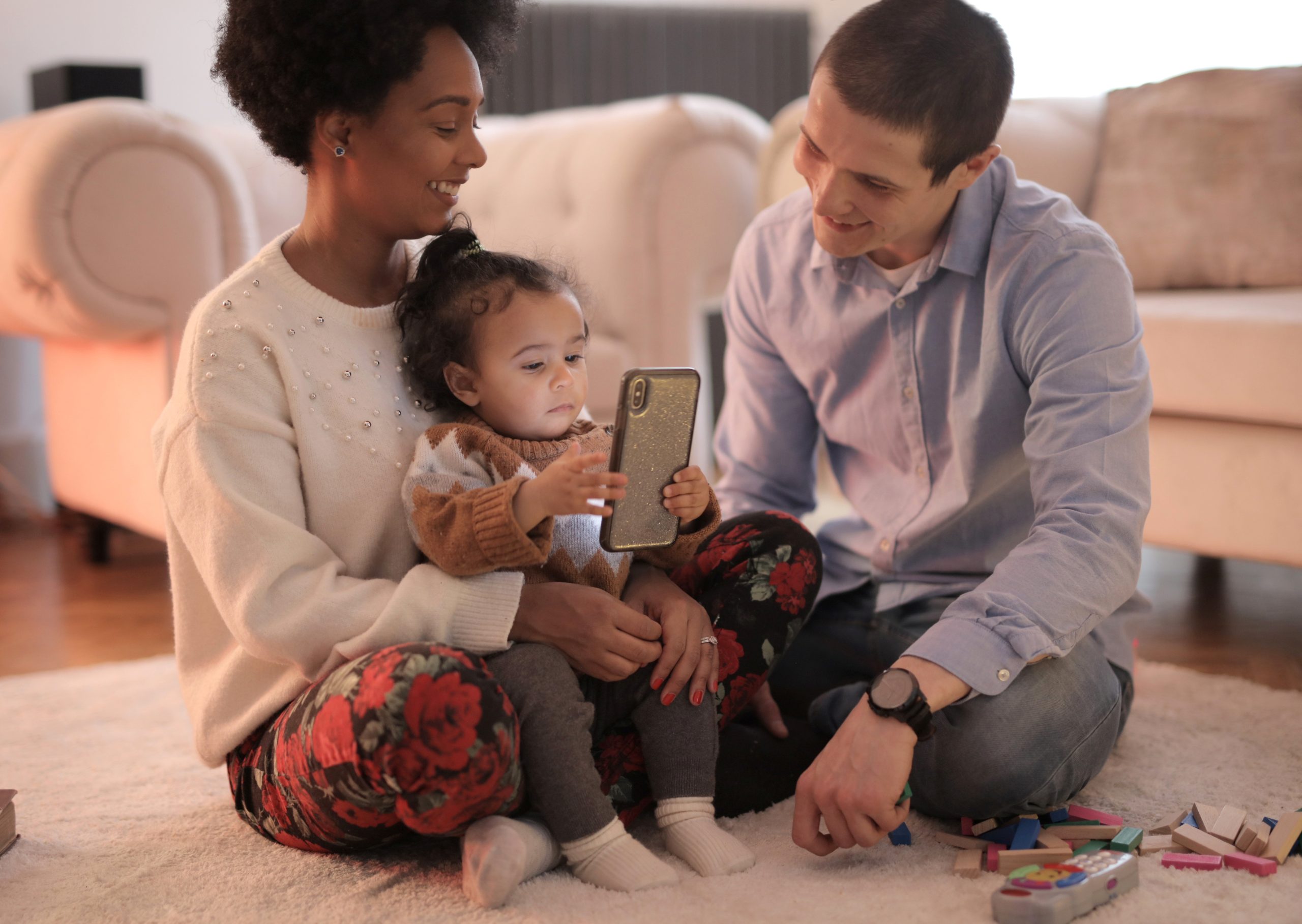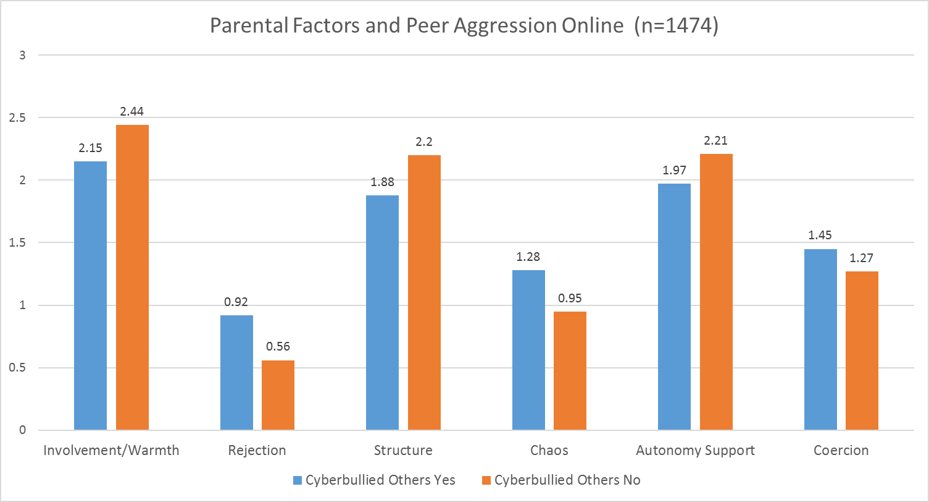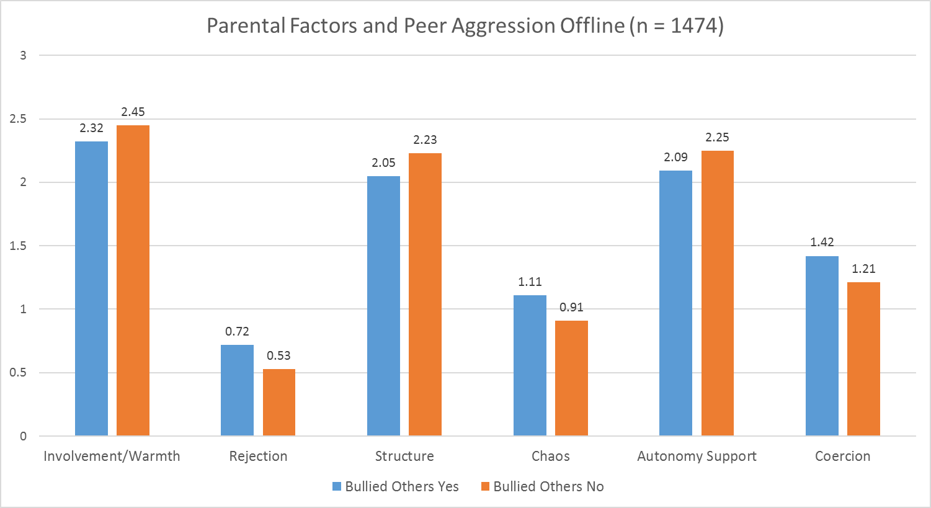
Parents and guardians have always had a powerful influence on the behaviors of children, while research is clear that peers tend to have more sway during the teenage years. That said, our new research published in the Journal of Child and Family Studies identifies that certain positive parenting practices have a strong effect on both school bullying and cyberbullying among middle- and high-schoolers in the US. These practices include a surplus of warmth, autonomy/support, and structure and a deficit of rejection, coercion, and chaos.
I’m currently the parent of two toddlers, and I struggle sometimes with warmth and affection (when they are driving me crazy – as toddlers can naturally do) and with determining the most effective disciplinary structure to teach respect, responsibility, and selflessness. But all of my work with teens has made me really self-aware and in need of constant recalibrating to determine what will lead to them making good choices as they grow up. It’s really hard, but the research speaks loud and clear: how we parent really does matter. If done well, it increases the likelihood of prosocial behaviors while decreasing negative choices by our children. And that’s my primary goal. Let’s dive into what we found in our latest academic paper.
A consistent theme uncovered through decades of social science research is that parenting practices have a meaningful differentiating effect on the lives of youth.1-3 Specifically, “positive parenting” is ideal – and is based on the best interest of the child and involves nurturing, empowering, encouraging, shepherding, and boundary-setting to enable their full development.4 These aspects of positive parenting have been linked to increased feelings of relatedness, better social and emotional functioning, and increased healthy and autonomous behavioral choices.5-8 As you think about how you were raised by your parents/guardians, this makes sense, right? These qualities at home also buffer against personal (e.g., emotional and psychological) and social (e.g., misbehaving peers, media, culture) pressures that might seek to push youth towards harming others and/or harming themselves.9-11
Three Dimensions of Positive Parenting
Over the years, scholars have identified three bilateral dimensions of positive parenting. First, warmth/rejection examines the extent to which parents are caring, affectionate, and generally bonded to the child (e.g., how responsive a parent is to a child). High warmth is associated with close emotional connections and acceptance, while high rejection often involves unhelpful criticism, derision, and outright hostility.12
Second, autonomy support/coercion identifies the ways children are able to develop into their own through independent thinking and problem solving (e.g., how demanding a parent is to a child). Parents who provide high autonomy support allow their children to express themselves and make informed behavioral choices within an age-appropriate framework of scaffolding.13 Highly coercive parents are overly controlling and dictatorial, demanding compliance without compromise or thorough explanation.14, 15
Third, structure/chaos examines the extent to which parents set clear expectations and consistently enforce rules (e.g., how much structure a parent provides to a child). High structure is evidenced by parents who provide their children with a regular routine involving certain supports to encourage and reinforce positive behavior, and who engage in predictable and logical discipline when expectations are not met.15 High chaos, conversely, involves an environment marked by capriciousness, disorganization, undependability, and erratic guidance, presence, and involvement.16, 17
Without getting into the specifics of our sample, methodology, and data analyses (see our paper for details), here are our high-level findings:
- Approximately 21% of US youth have bullied someone else at school in at least one or more ways in the last 30 days.
- Approximately 5% of US youth have bullied someone else online in at least one or more ways in the last 30 days.
- Positive parenting in the form of warmth, structure, and autonomy/support were associated with lower both bullying and cyberbullying to a statistically significant degree (meaning the relationship is not random but based on patterns found among the youth studied).
- Negative parenting in the form of rejection, chaos, and coercion were associated with higher levels of bullying and cyberbullying to a statistically significant degree.
- Parental influence has a stronger impact on cyberbullying as compared to traditional bullying.


So, where do we go from here? What can we do with these findings?
To begin, it is clear that positive parenting in the form of warmth, autonomy/support, and structure can prevent bullying behaviors at school and online while rejection, coercion, and chaos increases the likelihood of those harmful behaviors. They must be present and prioritized in homes, and instruction/guidance from societal institutions and culture can help make them known and be applied. To be sure, it was curious that parenting seems to matter more to constrain cyberbullying when compared to school bullying. This may be related to related to Travis Hirschi’s18 concept of “virtual supervision” wherein youth consider the responses of their parents even when they are not directly being supervised. This hesitance to disobey or make wrongful choices is because the parents may later find out about them, and the child does not want to risk upsetting those with whom they are strongly bonded.
These results directly inform other actionable strategies to assist parents and guardians. Generally speaking, parental education and training through partnerships with the school can be valuable to prevent traditional bullying,19, 20 while sending written material home,19, 21 the hosting of parent events by the school,22 and providing online resources23 can help parents grow in their awareness to prevent cyberbullying. Family counseling24, 25 and formal programs like parent management training26 and functional family therapy27, 28 can help address long-standing problematic parent-child relations.
Parental Monitoring Software and Cyberbullying: A Caveat
Also important to any discussion of parenting and cyberbullying is the matter of technological controls. Third-party software is available for all types of devices to perform monitoring and tracking functions of user activity, and thereby can provide parents with an idea of the types of content they are creating (and receiving).29 In addition, most devices have “Settings” which can enable restrictions on screen time hours, app usage, and other controls to manage what a child can do online (and with whom). Software has proven useful in decreasing a child’s exposure to sexual content,30 but not to harassment,31 and so parents shouldn’t download and install monitoring software under the assumption that it is a panacea. That said, it can help keep a parent or guardian “in the know” on some level.
When we give talks to parent groups, Justin and I continue to emphasize the following disclaimer: if parents choose to surreptitiously monitor the online activities of their children, they eventually will stumble upon something that raises concern, and will use it to confront their child. However, if the child did not know they were being monitored, it may very well undermine any foundation of trust that existed between the two parties.32 To prevent this, it is recommended that parents openly communicate to their children if they will be using monitoring software simply in order to keep them safe as they navigate online, and most importantly, co-create the governing rules in the household.33 Furthermore, parents should explain that if their child makes mature and responsible decisions over time, they will be given more freedoms and earn more privacy.34 Calm, healthy, and nonjudgmental dialogue with a child about what the pros and cons of social media, gaming, and other online activities sets a tone that invites continued open communication about anything negative that might occur, and consequently can keep them from going underground and hiding their experiences out of fear and shame.35, 36
For us, here’s what it comes down to: active mediation (talking about their child’s technology use), restrictive mediation (setting rules and using software to impose restrictions as needed), and co-using (being involved in their online activities to some degree) hold the most promise.37-39 All of this said, more research is required to measure their specific impact in reducing online risks.40 We’ll continue to keep you updated as to what we (and the rest of the field) discover in our efforts to equip and empower parents and guardians to optimally raise their children in this technology-suffused landscape.
***If you are not able to access our article online, please email us and we’ll send you a copy for your educational purposes.
Suggested citation: Hinduja, S. & Patchin, J. W. (2022). Bullying and cyberbullying offending: The influence of six parenting dimensions among US youth. Journal of Child and Family Studies, 31, 1454-1473.
Featured Image: Photo by Andrea Piacquadio from Pexels
References
1. Pinquart M. Associations of parenting dimensions and styles with externalizing problems of children and adolescents: An updated meta-analysis. Developmental psychology. 2017;53(5):873. https://doi.org/10.1037/dev0000295
2. DeVore ER, Ginsburg KR. The protective effects of good parenting on adolescents. Current opinion in pediatrics. 2005;17(4):460-465. https://doi.org/10.1097/01.mop.0000170514.27649.c9
3. DiClemente RJ, Wingood GM, Crosby R, et al. Parental monitoring: Association with adolescents’ risk behaviors. Pediatrics. 2001;107(6):1363-1368. https://doi.org/10.1542/peds.107.6.1363
4. Daly M, Abela A. Parenting in contemporary Europe: a positive approach. vol 2. Council of Europe; 2007.
5. Pastorelli C, Lansford JE, Luengo Kanacri BP, et al. Positive parenting and children’s prosocial behavior in eight countries. Journal of child Psychology and Psychiatry. 2016;57(7):824-834. https://doi.org/10.1111/jcpp.12477
6. Steinberg L, Silk JS. Parenting adolescents. Handbook of parenting. 2002;1:103-133. https://doi.org/10.1007/s10826-021-02208-7
7. Zimmer-Gembeck MJ, Collins WA. Autonomy development during adolescence. In: Adams GR, Berzonsky M, eds. Blackwell Handbook of adolescence Blackwell Publishers; 2003:175-204.
8. Farkas MS, Grolnick WS. Examining the components and concomitants of parental structure in the academic domain. Motivation and Emotion. 2010;34(3):266-279. https://doi.org/10.1007/s11031-010-9176-7
9. Baldry AC, Farrington DP. Protective factors as moderators of risk factors in adolescence bullying. Social Psychology of Education. 2005;8(3):263-284. https://doi.org/10.1007/s11218-005-5866-5
10. Dodge KA, Coie JD, Lynam D. Aggression and antisocial behavior in youth. Handbook of child psychology. 2006;https://doi.org/10.1002/9780470147658.chpsy0312
11. Kochenderfer-Ladd B, Skinner K. Children’s coping strategies: Moderators of the effects of peer victimization? Developmental psychology. 2002;38(2):267. https://doi.org/10.1037/0012-1649.38.2.267
12. Schaefer ES. Children’s reports of parental behavior: An inventory. Child development. 1965:413-424. https://doi.org/10.2307/1126465
13. Zimmer-Gembeck MJ, Locke EM. The socialization of adolescent coping behaviours: Relationships with families and teachers. Journal of adolescence. 2007;30(1):1-16. https://doi.org/10.1016/j.adolescence.2005.03.001
14. Baumrind D. Differentiating between confrontive and coercive kinds of parental power-assertive disciplinary practices. Human Development. 2012;55(2):35-51. https://doi.org/10.1159/000337962
15. Grolnick WS, Ryan RM. Parent styles associated with children’s self-regulation and competence in school. Journal of educational psychology. 1989;81(2):143. https://doi.org/10.1037/0022-0663.81.2.143
16. Skinner E, Johnson S, Snyder T. Six dimensions of parenting: A motivational model. Parenting: Science and practice. 2005;5(2):175-235. https://doi.org/10.1207/s15327922par0502_3
17. Crandell JL, Sandelowski M, Leeman J, Havill NL, Knafl K. Parenting behaviors and the well-being of children with a chronic physical condition. Families, Systems, & Health. 2018;36(1):45. https://doi.org/10.1037/fsh0000305
18. Hirschi T. Causes of delinquency. University of California Press; 1969.
19. Finkelhor D, Vanderminden J, Turner H, Shattuck A, Hamby S. Youth exposure to violence prevention programs in a national sample. Child abuse & neglect. 2014;38(4):677-686. https://doi.org/10.1016/j.chiabu.2014.01.010
20. Ttofi MM, Farrington DP. Effectiveness of school-based programs to reduce bullying: A systematic and meta-analytic review. Journal of Experimental Criminology. 2011;2011(7):27-56. https://doi.org/10.1007/s11292-010-9109-1
21. Salmivalli C, Kärnä A, Poskiparta E. Counteracting bullying in Finland: The KiVa program and its effects on different forms of being bullied. International Journal of Behavioral Development. 2011;35(5):405-411. https://doi.org/10.1177/0165025411407457
22. Schultze‐Krumbholz A, Schultze M, Zagorscak P, Wölfer R, Scheithauer H. Feeling cybervictims’ pain—The effect of empathy training on cyberbullying. Aggressive behavior. 2016;42(2):147-156. https://doi.org/10.1002/ab.21613
23. Cross D, Shaw T, Hadwen K, et al. Longitudinal impact of the Cyber Friendly Schools program on adolescents’ cyberbullying behavior. Aggressive behavior. 2016;42(2):166-180. https://doi.org/10.1002/ab.21609
24. Nickel MK, Muehlbacher M, Kaplan P, et al. Influence of family therapy on bullying behaviour, cortisol secretion, anger, and quality of life in bullying male adolescents: A randomized, prospective, controlled study. The Canadian Journal of Psychiatry. 2006;51(6):355-362. https://doi.org/10.1177/070674370605100604
25. Hernandez EJ. Reducing bullying and preventing dropout through student engagement: A prevention-focused lens for school-based family counselors. International Journal for School-Based Family Counseling. 2016;7:1-13.
26. Kazdin AE. Parent management training: Treatment for oppositional, aggressive, and antisocial behavior in children and adolescents. Oxford University Press; 2008.
27. Fiese BH, Celano ME, Deater-Deckard KE, Jouriles EN, Whisman MA. APA handbook of contemporary family psychology: Family therapy and training, Vol. 3. American Psychological Association; 2019.
28. Sexton TL. Functional family therapy in clinical practice: An evidence-based treatment model for working with troubled adolescents. Routledge; 2011.
29. Heitner D. Screenwise: Helping kids thrive (and survive) in their digital world. Routledge; 2016.
30. Ybarra ML, Finkelhor D, Mitchell KJ, Wolak J. Associations between blocking, monitoring, and filtering software on the home computer and youth-reported unwanted exposure to sexual material online. Child Abuse & Neglect. 2009;33(12):857-869. https://doi.org/10.1016/j.chiabu.2008.09.015
31. Ybarra ML, Mitchell JK. Youth engaging in online harassment: associations with caregiver-child relationships, Internet use, and personal characteristics. Journal of Adolescence. 2004;27(3):319-336. https://doi.org/10.1016/j.adolescence.2004.03.007
32. Law DM, Shapka JD, Olson BF. To control or not to control? Parenting behaviours and adolescent online aggression. Computers in Human Behavior. 2010;26(6):1651-1656.
33. Mesch GS. Parental mediation, online activities, and cyberbullying. CyberPsychology & Behavior. 2009;12(4):387-393.
34. Patchin JW, Hinduja S. Bullying Today: Bullet Points and Best Practices. Sage Publications; 2016.
35. Livingstone S, Blum-Ross A. Parenting for a Digital Future: How Hopes and Fears about Technology Shape Children’s Lives. Oxford University Press, USA; 2020.
36. Smahelova M, Juhová D, Cermak I, Smahel D. Mediation of young children’s digital technology use: The parents’ perspective. Cyberpsychology: Journal of Psychosocial Research on Cyberspace. 2017;11(3) https://doi.org/10.5817/CP2017-3-4
37. Chen VHH, Chng GS. Active and restrictive parental mediation over time: Effects on youths’ self-regulatory competencies and impulsivity. Computers & Education. 2016;98:206-212.
38. Lee S-J. Parental restrictive mediation of children’s internet use: Effective for what and for whom? New media & society. 2013;15(4):466-481.
39. Chen L, Shi J. Reducing harm from media: A meta-analysis of parental mediation. Journalism & Mass Communication Quarterly. 2019;96(1):173-193.
40. Livingstone S, Helsper EJ. Parental mediation of children’s internet use. Journal of broadcasting & electronic media. 2008;52(4):581-599. https://doi.org/10.1080/08838150802437396







